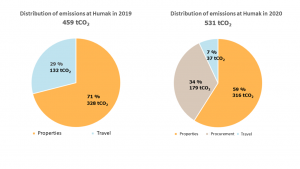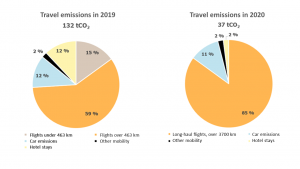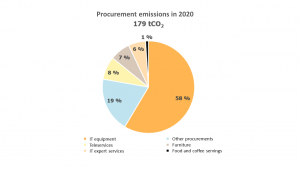Building a Carbon Neutral Humak – “Sustainable Wednesday Blog Series, Part 2”

Universities of Applied Sciences are committed to the Rector’s Conference of Finnish Universities of Applied Sciences Arene‘s programme for sustainable development and responsibility. The common goal of universities of applied sciences is to be sustainable, responsible and carbon neutral by 2030.
This blog series elaborates on how Humak takes into account the principles of sustainable development in the areas of education, RDI work as well as management and personnel competence from an ecological, social and cultural point of view. Additionally, the sustainable development program involves an annual calculation of our carbon footprint, through which Humak strives to reduce its own impact on the climate. In the blog series, we also present the basics of the calculation and the evolution of Humak’s carbon footprint. Blog posts will be published about once a week on Wednesdays until May 2022. The Sustainable Wednesday blog series continues with blog number two: Building a Carbon Neutral Humak.
Blog 2: “Building a Carbon Neutral Humak”
Monitoring the evolution of our carbon footprint will help us see what we need to pay attention to in order to act responsibly and sustainably. To enable comparability, universities of applied sciences calculate their carbon footprint using a commonly agreed calculation method that takes into account carbon emissions related to procurements, travel and maintenance of properties. Of these, Humak can have the biggest impact on travel and procurements. We can only indirectly influence the emissions caused by real estate, as our campus network is based on rental properties.
In Part 2 of the Sustainable Wednesday blog series, we focus on the development of Humak’s carbon footprint between 2019 and 2020. Our staff’s thoughts on how to reduce our carbon footprint are also discussed.
Basics of Calculating the Carbon Footprint
Humak’s carbon footprint has been calculated in 2019 and 2020 (see Figure 1). The two years are not fully comparable due to the different calculation method. In 2020, emissions from procurements were also taken into account in the calculation, which explains the clear increase in emission volumes. If we exclude procurements from the 2020 calculation, our carbon emissions decreased by 23 percent compared to the previous year. The most significant emission reduction occurred in travel. In 2019, travel accounted for 29 percent of total CO2 emissions, as opposed to only 10 percent in 2020 when COVID-19 restrictions were at their worst.

How You Travel Matters
The calculation of emissions from travel took into account all flights, car traffic documented on travel invoices, rental buses, boat traffic and hotel stays, as well as study trips organized by Humak for students. Train travel was no longer taken into account in the 2020 calculation, though it was still included in 2019. On the other hand, daily commuting to and from campuses is not yet included in the carbon footprint calculation of universities of applied sciences.
The largest emissions in terms of travel came from air travel (see Figure 2). Of the carbon footprint in 2019, flights accounted for 74 percent. In 2020 – when travel virtually ceased due to COVID-19 – they accounted for 85 percent. In 2020, emissions from travel decreased to less than a third of the emissions of the previous year.

During the pandemic, Humak’s emissions from travel have been small regardless, so as the situation normalizes, it is important to make sure that our emissions do not rise to the same level as previously or above. In order to reduce emissions from travel and mobility, Arene’s carbon footprint task group will draw up a joint recommendation for travel rules for universities of applied sciences in the spring of 2022. In practice, this means avoiding air travel whenever possible as well as using a carbon-neutral alternative to one’s own car.
However, it is not always possible to influence the ways of traveling, as not all Humak campuses are well connected by public transport. However, small everyday choices have an effect: avoid unnecessary travel and favor remote meetings and negotiations. However, if it is necessary to travel, environmentally friendly solutions, such as carpooling and public transport, should be used whenever possible.
Real Estate Is Our Most Significant Source of Emissions
In the calculation of emissions from Humak’s properties in 2019–2020, the average value for rental properties 44 kgCO2 / brm2 was used. The calculation takes into account, for instance, energy and water consumption, waste management and other maintenance-related costs. The calculation also took into account the size of Humak’s rental premises. Humak has campuses in six regions and also separate RDI concentrations in Turku, Kuopio and Imatra. The number of square meters of Humak’s leased premises decreased by 4 percent in 2020 from the previous year. Thus, emissions from real estate decreased in the same proportion.
With digitalization and COVID-19, the way we work and study has changed. The need for facilities has also clearly decreased at Humak, as more than a third of all Humak students study partially or entirely online. In addition, according to a service survey conducted by Humak in January 2022, the occupancy rate of staff premises is currently very low – even more than a half of the respondents feel that they are better able to perform their duties elsewhere than at their own workplace.
With Sustainable Procurement for a More Responsible Everyday Life
As emissions from procurement are now also taken into account, Humak’s carbon footprint in 2020 increased by 16 percent from 2019. Emissions from procurement cover up to 34 percent of Humak’s carbon footprint, with IT equipment being the largest at almost 60 percent. In addition to IT equipment, this included IT expert and telecommunications services, furniture, communications marketing materials, library materials and food and coffee services. The high share of IT equipment is not surprising, as the electronics industry is one of the most major sources of emissions in the world. In addition, digitalization will increase further with more comprehensive mobile services and streamed videos.
In the future, more attention must be paid to the life cycle of devices – such as laptops and mobile phones. The longer we use them, the less devices have to be produced and the less emissions are generated. At Humak, the average lifespan of a laptop is four years.

Staff Involved in Carbon Footprint Work
How would our staff go about reducing Humak’s carbon footprint in the future? They got to answer this during Humak’s development days in February. Some believed that remote teaching would be the answer, whereas others preferred contact teaching. On one hand, some staff members wanted Humak to switch completely to e-learning to reduce the carbon footprint of travel. On the other hand, there were concerns about emissions from teleworking, which should not be downplayed. Some considered it important that a suitable balance should be found between these.
Our personnel highlighted the use of carbon neutral online services and sustainable service providers as a means of reducing emissions from IT services. Acquiring and increasing the longevity of low-emission equipment was also mentioned by many. Travel should only be done after careful consideration and carpool rides should be preferred in everyday situations if public transport is not possible.
Our staff wanted clear and concrete practical goals for reducing our carbon footprint and monitoring them in real time. They also found sharing practical tips to implement one’s own responsibility and sustainability important. Emission offsets were seen as supportive of the reduction of the carbon footprint. However, they are not seen as the preferred solution. With regard to procurement, more critical judgment should be used in the future, for example in terms of corporate gifts. Moving towards intangible gestures is preferable.
Goals to Be Achieved by 2030
Humak has not yet taken goal-oriented emission reduction measures in accordance with the sustainable development program and the roadmaps for its various components – education, RDI work, personnel management and carbon footprint. Now is the time to take action and begin conscious and goal-oriented work towards a carbon neutral Humak 2030. This is done in collaboration with the Humak community, our partners and the entire university field. During 2022, our intention is to draw up a roadmap for Humak’s sustainability program and its various components.

